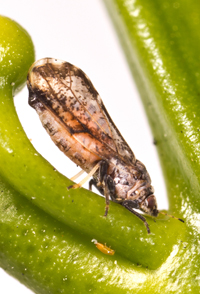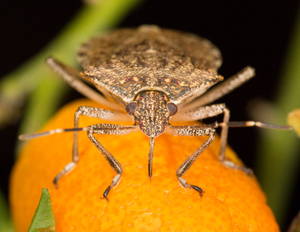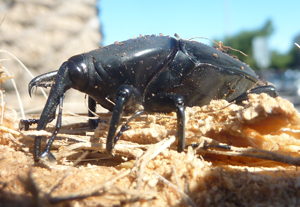How many Non-Native Invertebrates Establish Each Year in California?
Prepared by Mark Hoddle, Extension Specialist and Director of Center for Invasive Species Research
mark.hoddle@ucr.edu
Personal Website
Summary of Major Points:
- Over the period 1700 to 2010, 1,686 non-native invertebrate species established in California
- The majority, ~84% (1,416 species) are insects, followed by mites (~8%), and spiders (~3%)
- Small sucking insects (e.g., aphids, whiteflies, scales, mealybugs) associated with live plants, account for ~28% of established insect species
- Approximately 44% of non-native invertebrates likely arrived from populations established elsewhere in North America (i.e., other parts of the USA and Canada)
- From 1970 to 1989, the annual rate of detection of established populations of new invertebrate species in California was ~6 per year. From 1990 to 2010, the annual rate increased to ~ 9 per year, a 50% increase
- Of the new invertebrate species that have established in California ~19% (314 species) are considered pests
- Changes in border security (i.e., the transition from USDA-APHIS to Customs Border Protection) after 11 September 2001 did not cause any statistically significant changes in the numbers of non-native invertebrate species detected annually in California
- Invasive species cost California a lot each year. In 1995, Robert Metcalf estimated that invasive pests cost California ~$100 per person (31.7 million people lived in California in 1995, so Metcalf's estimate was around $3.17 billion in 1995 dollars). In 2016, the population of California was estimated at 39.2 million, so adjusting for inflation and population growth, Metcalf's 1995 estimate would be $6.18 billion per year.
Why is California Susceptible to Invasive Pests that Cause Economic and Ecological Damage?
California is a major agricultural, industrial, trade, and tourist hub on the Pacific Coast of the USA. As a consequence of high levels of trade, tourism, and bewildering diversity of agricultural crops, climates and habitats (i.e., beaches, deserts, mountains with snow, and densely populated urban areas), it is not surprising that a large number of non-native invertebrates (e.g., insects and mites) establish in California each year.

How Do These New Organisms Reach California?
Human activity (i.e., trade and tourism) provides the mechanisms and opportunities for unwanted introductions of new species into California from faraway places (e.g., Europe, Central America and the Pacific Islands). These new organisms may be accidental hitch hikers in cargo, or they may be deliberately smuggled into California. Rapid transportation, especially air travel (i.e., hours on a plane as opposed to days, weeks, or months on a boat), makes it likely many hitch hikers will survive long distance journeys.
For metrics of introduction pressure in California consider these statistics; in 2010 (these are the most recent data available from the California Department of Food and Agriculture’s [CDFA] terrestrial border stations), 27.3 million private vehicles entered the state along with 7.14 million private trucks. Over January - December 2015, Los Angeles International Airport (LAX) serviced a total of 54 million domestic (a 5% increase over 2014) and 21 million international (an 8.5% increase over 2014) passengers. The number of aircraft visits to LAX in 2015 were around 656,000 which was about 3% higher than 2014. LAX is the fifth busiest airport in the world and second busiest in the United States. There are about 692 flights to 85 domestic cities each day and 928 weekly nonstop flights to 67 cities in 34 countries on 59 passenger air carriers. Combine these statistics for LAX with international airports in San Diego, San Francisco, Oakland, Sacramento, and major seaports (e.g., Long Beach) and the amount of human and cargo traffic entering California each year is astronomical! Flight statistics for LAX can be accessed here.
Diverse Habitats and Climates in California
Further, the diversity of natural (e.g., pine and oak forests) and man-made habitats (e.g., irrigated urban or agricultural areas landscaped with exotic plants in desert areas) and climates (e.g., cool coastal areas to hot desert interior zones to temperate mountain ranges) results in food-habitat-climate combinations that probably ease establishment barriers for exotic organisms that are introduced accidentally into California. If something new arrives, and it is lucky, it will probably find the right types of food and climate to thrive in!
Making an Inventory of Non-Native Invertebrates Living in California
In relation to the invasion threats that California faces annually, a critical question that was posed in a recent publication by Dowell et al., (2016) was this: “On average, how many new invertebrate species establish each year in California?” To answer this question Bob Dowell put together an inventory of non-native macro-invertebrates that established in California over the period 1700 to 2010. These records were gleaned from the published literature, web pages, museum, state, and federal agency reports. For an organism to be incorporated into the list the following criteria had to be met: (1) One or more authorities noted that the organism was found in California, (2) these sources confirmed that the species was not native to California, (3) populations of these new species were breeding and spreading, (4) if the organism was recorded entering/establishing in California multiple times, only the first report of establishment was used for analyses, and (5) arthropod natural enemies deliberately released for classical biological control of arthropods (i.e., parasitoids and predators) or weeds (i.e., herbivorous insects) were not included, and neither was the deliberately introduced honey bee.

How Many Non-Native Invertebrates Have Established in California?
So what did Dowell and his co-authors discover after compiling this massive data set documenting accidental introductions of non-native invertebrates over a 310 year period?
The inventory that was compiled indicated that at least 1,686 exotic terrestrial invertebrates from 278 different families have established in California. The majority of these, ~84%, were insects, followed by mites (~8%), and spiders (~3%). Sucking bugs in the order Hemiptera, comprised ~28% (~ 183 species) of non-native insects that established in California. The most common types of non-native insects that established tended to be small cryptic plant feeders that are hard to see (e.g., scales, mealybugs, whiteflies, and aphids) and they probably arrived on living plant material (Liebhold et al. 2012).
Consequently, the composition of invaders entering California deviates from what would be expected if species introductions were purely random. Liebhold et al. 2016 made similar findings supporting the idea that some invasive insect groups are typically over represented in non-native assemblages, and this may result from introduction pathways (e.g., live plants) or biology (e.g., environmental tolerances).
Where Have these New Arrivals Come From?
The majority of established exotic species, ~44%, arrived from populations that were either native to other parts of the USA (e.g., glassy-winged sharpshooter is native to the SE USA) or had previously established elsewhere in North America (e.g., fire ants are native to South America, and populations in California probably originated from the SE USA where this pest is widespread), and most likely did not arrive directly in California from their native countries. Europe was the second biggest direct contributor of non-native invertebrates to California (~25% of species came directly to California from Europe), followed by Asia (~10%).
What are the Rates of Arrival into California?
The date of first detection is known for about 66% (1,116) of species and rates of invasion over time have not remained constant. Dowell and Gill (1989) noted that over the period 1970-1989 around 6 species were establishing, on average in California each year (the revised data set in Dowell et al. 2016 has about the same average). From 1990-2010, the detection data set suggests that this rate of establishment has increased by about 50%, to ~9 species per year.
How Many of these New Arrivals Are Pests?
In some cases these new introductions become serious pests, while other species blend into the landscape and don’t cause noticeable problems. Dowell et al. (2016) used the UC-IPM website to determine how many of these established non-native invertebrates are pests in California. It was estimated that about 314 species, or ~19%, of these introduced species are important pests in California.

Did 9/11 Affect Invasion Rates into California?
The Dowell data set allowed the testing of an important question: “Did invasion rates into California change after 11 September 2001?” It had been suggested that the removal of USDA-APHIS inspectors trained primarily to detect unwanted pest organisms at border crossings with Customs Border Protection personnel trained to detect terrorists and drug traffickers may have increased the risk of pest introductions into the USA (GAO 2006). Statistical analyses failed to detect any significant changes in the rates at which new organisms established in California after 9/11. However, many factors may influence this non-significant finding, including insufficient time having elapsed since border management practices changed and first detections of new organisms occurs, or inconsistent sampling efforts for detection of new species in California post 9/11.
Conclusions
It is likely that the rate (and diversity) at which non-native species are introduced and subsequently establish in California will continue to increase as a result of increasing tourism and trade. Potential problems to agricultural, urban, and wilderness areas will probably continue to increase as well as there is a corresponding diminishment of resources for pest surveillance, detection, and post-incursion management for managing unwanted pest introduction
References Cited
- Dowell, R.V. and R.J. Gill. 1989. Exotic invertebrates and their effects on California. Pan Pacific Entomologist 65: 132-145.
- Dowell, R.V., R.J. Gill, D.R. Jeske, and M.S. Hoddle. 2016. Exotic terrestrial macro-invertebrate invaders in California from 1700 to 2010: An analysis of records. Proceedings of the California Academy of Sciences Series 4, volume 63, No. 3, pp. 63-157.
- GAO. 2006. Homeland security management and coordination problems increase the vulnerability of U.S. agriculture to foreign pests and diseases. GAO-06-644. http://www.gao.gov/products/GAO-06-644
- Liebhold, A.M., E.G. Brockerhoff, L.J. Garrett, J.L. Parke, and K.O. Britton. 2012. Live plant imports: the major pathway for forest insect and pathogen invasions of the US. Frontiers in Ecology and the Environment. 10: 135-143.
- Liebhold, A.M., T. Yamanaka, A. Roques, S. Augustin, S.L. Chown, E.G. Brockerhoff, and P. Pyšek. 2016. Global composition variation among native and non-native regional insect assemblages emphasizes the importance of pathways. Biological Invasions 18: 893-905.

